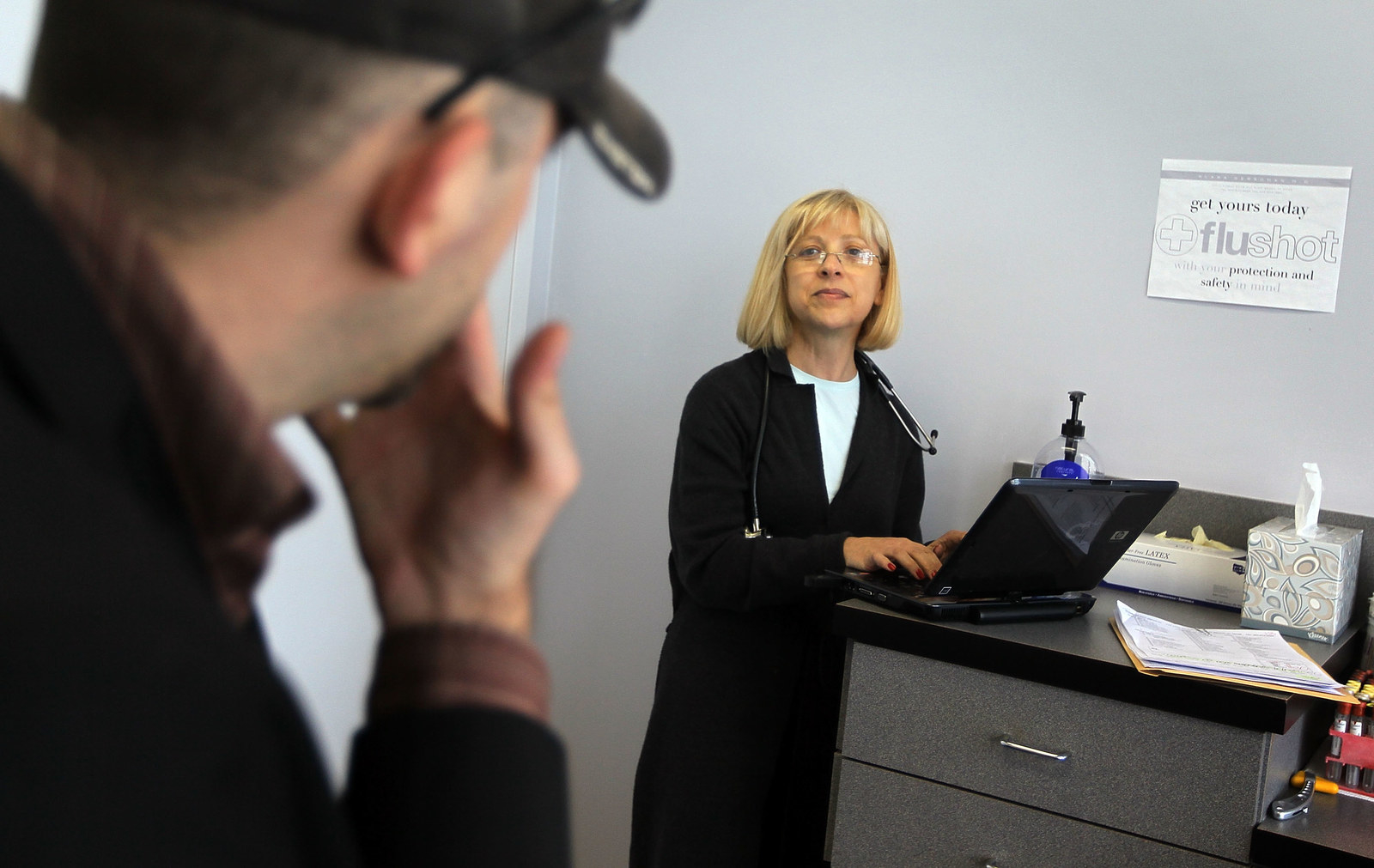
The United States has poured billions into digitizing medical records in the hopes of making them safer. But as a seemingly growing number of lawsuits indicates, this new tech has serious problems of its own.
In 2012, a patient left PinnacleHealth, a hospital system in central Pennsylvania, with a list of medicine prescriptions allegedly generated by the facility’s medical software. But days later he had “practically no blood pressure,” so he returned to the emergency department — where he was told the prescriptions “should never have been given to him,” according to court documents.
At other times, the software mistakenly showed some patients as missing from their hospital beds, which meant that they couldn’t receive their medications, Pinnacle said in court documents. The system also experienced alleged outages and crashes. At other times, the hospital’s pharmacy allegedly didn’t receive orders entered in the software, forcing patients to wait for their medications.
Incidents like these, alleged by Pinnacle in court documents filed this year, underscore the dark side of the digitization of patients’ health records, a massive effort over the last few decades to make United States health care better, cheaper, and more automated and efficient.
When you pay a visit to your doctor’s office or a hospital, chances are your physician will have one eye on your electronic health record the whole time. It’s the all-important history of your illnesses, allergies, vaccinations, medications, and family’s health, which is stored on the software doctors and nurses use to look up these facts, order prescriptions and lab tests, make treatment decisions, spot problems, communicate with each other about you, and more. This software plays an essential role in health care — yet it can also, directly or indirectly, lead to mistakes that put patients’ safety at risk.
“Although most sensible people believe that care is safer with an electronic system than without them, we have all become aware there are new kinds of errors that can be introduced,” Dr. Robert Wachter, chief of the hospital medicine division at UC San Francisco, told BuzzFeed News.
With Medical Liabilities Come Lawsuits
And these errors are increasingly cropping up in lawsuits. Currently, electronic health records are cited in only 1 percent of medical liability claims, according to The Doctors Company, the nation’s largest physician-owned medical malpractice insurer, which analyzed 97 claims from 2007 to mid-2014. But it found that 26 claims were filed in the first half of 2014, almost as many as were filed in all of 2013, a sign they may be on the rise. Before that, there were two from 2007 to 2010, 19 in 2011, and 22 in 2012, according to the analysis, which was published in early 2015.
This software plays an essential role in health care — yet it can also, directly or indirectly, lead to mistakes that put patients’ safety at risk.
Because three or four years typically pass between when an incident happens and a claim is actually filed, the number of such claims will “undoubtedly” grow, said medical director Dr. David Troxel of The Doctors Company.
Pinnacle’s claims in particular are part of a more-than-yearlong dispute with its electronic health record vendor, Siemens, which is now owned by Cerner, one of the largest such companies in the country. The litigation began in June 2015 when Cerner sued Pinnacle for allegedly trying to breach its contract in order to switch to another service, and for failing to pay its bills — at the time, allegedly more than $5 million.
But the three-hospital system denies Cerner’s allegations and, in documents filed in May in Pennsylvania court, argued that Siemens and Cerner had effectively breached the contract because the software’s performance over the years was a “consistent failure” that “left Pinnacle with no realistic alternative but to retain another software provider.” In its latest counterclaim, Pinnacle said staff had flagged more than 250,000 tickets for problems related to Siemens’ software since 2007, “many” of which “jeopardized the care and safety of the patient population served by Pinnacle.”
A Cerner spokesperson told BuzzFeed News, “Patient safety is of the utmost importance to Cerner.” A Pinnacle spokesperson declined to comment.
Man-versus-machine struggles in the core of our medical system are usually invisible to you when you go in for a check-up or a prescription or surgery. But if they cause medical errors, and go unchecked, they can have deadly consequences.
When a Drop-Down Menu Could Hurt You
Health care providers have been making mistakes long before health care went digital. In 1999, the Institute of Medicine estimated that between 44,000 and 98,000 people in the US died every year of preventable medical errors. That landmark finding made clear the disadvantages of paper — it’s easily lost and damaged; it permits sloppy handwriting; it’s hard to trace and share a paper trail — and this helped push clinicians to see technology as a potential solution.

Even so, health care’s digitization has been slow-moving. As recently as 2008, three decades after the first electronic health records systems were developed, only 17 percent of doctors’ offices and 9 percent of hospitals had basic electronic records. That began to change under a 2009 law under the economic stimulus bill that appropriated $35 billion to incentivize the adoption of electronic health records made by companies like Epic, Cerner, McKesson, AllScripts, and AthenaHealth. By 2014, half of doctors’ offices and three-fourths of hospitals in the US used basic electronic records, which are systems that contain clinical information but lack more sophisticated support features.
Digital records do seem to be safer, studies have found — but they have introduced their own, unexpected ways to make mistakes.
One common problem occurs when doctors try to save time by copying and pasting information from one patient’s record to either a new page in the same patient’s record or a different patient’s record to save time, but forget to edit out old or irrelevant text. Such was the case of a toddler who returned with a fever, rash, and fussiness after an international trip. According to The Doctors Company, the physician thought it was a bug bite or flu, and kept pasting old text from the toddler’s record that hadn’t been updated to note that his travels had potentially exposed him to tuberculosis. Two weeks later, the child was diagnosed with tuberculous meningitis, but by then he had developed “permanent and severe” cognitive defects.
Pinnacle said staff had flagged more than 250,000 tickets for problems related to Siemens’ software since 2007, “many” of which “jeopardized the care and safety of the patient population served by Pinnacle.”
Another patient was transferred to a skilled nursing facility with an order for a blood-thinning medication, but a doctor didn’t comment on the prescription, so it went unfilled. During dialysis, the patient began bleeding and died after severe blood loss. Experts said the software should have sent out an alert about the prescription, according to The Doctors Company.
A different physician at a different facility meant to order 15 milligrams of morphine sulfate for a patient, but accidentally chose the next option in the drop-down menu: 200 milligrams. The patient ended up in the emergency room overnight, according to The Doctors Company.
And in yet another case, a nurse at UC San Francisco accidentally ordered a patient 38.5 tablets of an antibiotic instead of one. The nurse hadn’t noticed that the medication-ordering screen in the Epic health records system was set, by default, to the wrong unit — milligrams per kilogram of the patient’s weight, not simply milligrams. Pablo Garcia, the 16-year-old patient, overdosed, had a seizure, stopped breathing, and nearly died.
In Garcia’s case, described in Wachter’s book The Digital Doctor, the nurse did make the wrong order, but Wachter writes that the screen was so cluttered that a busy worker was unlikely to see at a glance that the unit was wrong. And while the nurse had overridden an alert that signaled it was an overdose, hospital staff see thousands of such alerts on monitors every day and many say they tend to become numb from the overexposure.
“Certainly there are human errors where it’s the doctor’s or nurse’s fault,” Wachter said, “but many errors are the faults of the machine because they set humans up to make errors and weren’t designed with user-centered principles.”

Who’s to Blame: Man or Machine?
What makes these problems stubborn is their many underlying and complex causes — and what they are often depends on whom you ask. Clinicians can have unrealistically high expectations for a computer system, or they are improperly trained — so they enter incorrect information and ignore alerts about health hazards.
Conversely, doctors blame companies for software that shuts down, fails to alert staff about hazards, and lacks the flexibility to enter important data about patients. Clinicians also accuse software companies of failing to consult doctors in order to make their programs user-friendly, of building walled-off systems incapable of sharing data with rival systems, and of not bothering to design any consistency into their software, so a doctor essentially has to start from scratch at hospitals with different systems.
Of the medical liability claims that involved electronic health records and were analyzed by The Doctors Company, the systems themselves contributed to 42 percent, while people using the systems contributed to 64 percent. (Some claims had multiple different factors.)
“Part of why many of these problems are so tricky is because responsibility is a little diffuse,” William Marella, executive director of operations and analytics of the ECRI Institute, a nonprofit that studies patient safety issues, told BuzzFeed News. “There isn’t one organization that can fix it on its own.”
The Electronic Health Record Association, a group that represents most vendors, said that it hasn’t heard about increasing numbers of lawsuits involving electronic health records and patient safety.
“Of course, our members are always striving for improvement, with particular focus on usability, interoperability, clinical workflow, patient needs, and continued innovation,” said Dr. Richard Loomis, vice chair of the association, in a statement.
What makes these problems stubborn is their many underlying and complex causes — and what they are often depends on whom you ask.
Even if the number of lawsuits rises, it may not be enough to force companies to fix their share of electronic health records’ problems. Many software vendor contracts contain clauses in which parties agree not to hold each other responsible for any loss, damage, or legal liability. And these disputes are typically settled out of court with nondisclosure clauses that keep patient safety issues from being openly discussed, according to Troxel of The Doctors Company.
But Dr. Keith Klein, a physician at Cedars-Sinai Medical Center who has testified in 350 medical legal cases, including some that involved electronic health records, said a lawsuit could be key to getting companies to heed doctors’ frustrations.
“What’s happening now is, there’s a number of lawyers around the country looking for a malpractice case where they can sue Epic or Athena(health) rather than the doctor,” Klein said. “Whether they win or lose, it’s going to make headlines and send a shudder through the industry. That may be the only way we can get them to change.”
The Office of the National Coordinator for Health Information Technology, the federal agency primarily in charge of promoting and implementing electronic health records, is looking to expand its relatively limited regulatory powers in this realm. For example, it currently delegates the task of testing and certifying electronic health records to outside bodies. But under a proposal introduced this spring, it wants to be able to directly review electronic health record systems, independent of those certifying bodies, and to quickly address potential public health and safety risks. So far, two health care information technology organizations have expressed some concern that the idea would grant the ONC too much authority.
For now, the agency has published guidelines for how to safely use records and embeds safety requirements into the certification program. It has also proposed a center that wouldn’t have investigatory power but would provide a forum for all parties involved with electronic health records, from software vendors to hospitals to regulators, to analyze problems and come up with solutions. So far, Congress has not funded the proposal.
Dr. Andrew Gettinger, chief medical information officer of the agency, acknowledges the entrenched difficulties of making records work for the health care system overall and that progress will be likely characterized by “incremental improvements.”
However, he believes that very few doctors actually want to go back to paper completely — and so at least the community is bound by a common purpose, however great its frustrations. “At some point, we will hit what I’m going to call my goal,” he said, “the time when doctors, nurses, and pharmacists can’t imagine practicing medicine without a computer because it makes them so much better.” But that future may be a long way off.
